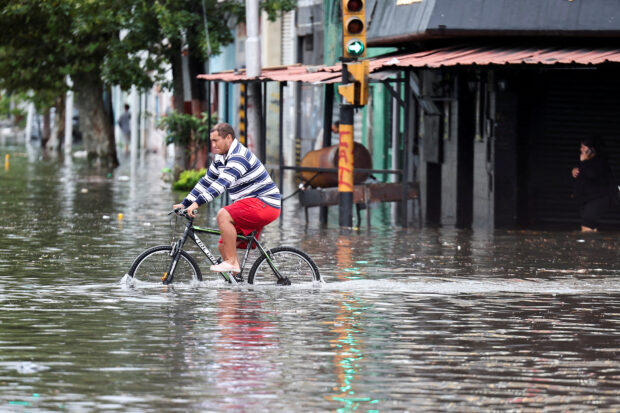
A man rides a bicycle through floods caused by heavy rains, in Avellaneda, in the outskirts of Buenos Aires, Argentina, March 12, 2024. REUTERS/Agustin Marcarian
BUENOS AIRES — Intense rains in Argentina are beginning to leave the soil too wet in key agricultural areas, which could also make it harder to harvest the 2023/24 soybean crop, a climate specialist said on Tuesday, though the conditions could be good for the 2024/25 wheat crop.
The heavy rains also caused flooding in parts of the city of Buenos Aires, with residents wading through up to waist-high waters and storms bringing “a lightning strike every second,” meteorologists said.
READ: Poverty in Argentina hits 20-year high at 57.4%, study says
In the past 24 hours, Argentina’s main agricultural regions have seen between 15 mm and 75 mm of rain, according to the national meteorological service, which predicts more over the next few days.
Growers in the Buenos Aires, Santa Fe and Entre Rios provinces have seen between 140 mm and 150 mm of rains so far this month, which is above average, meteorologist German Heinzenknecht said in an interview, adding the areas are likely to see similar amounts in the rest of March.
“We’re going to potentially close out March with excessive wetness in a large part of the core agricultural area,” said Heinzenknecht, a meteorologist at the Applied Climatology Consulting Firm (CCA).
“The harvest in some sectors might not be so easy due to this issue,” he added.
In coming weeks, as the Southern Hemisphere summer turns to autumn, farmers will begin to harvest soybeans, which are largely turned into oil and flour. Argentina is a top global supplier of both.
With high soil humidity and combines unable to trudge through the mud, soy plants could lose beans from pods that open, or beans could begin to sprout or fungi could begin to grow.
“The important thing now is for the rains to not keep going in April,” Heinzenknecht said, adding less precipitation is forecast for the month.
However, Agriculture Secretary Fernando Vilella told reporters at the U.S. Chamber of Commerce in Argentina that the recent rains for now continue to favor soybean growth.
“It is raining and this is good to ensure the soybeans’ final productivity,” Vilella said.
The Rosario grains exchange estimates the 2023/24 soybean harvest at 49.5 million metric tons.
Good news for wheat
The abundant rains are good for wheat planting, which begins in May.
“The outlook is favorable, because we have to replenish the soil, we have to keep it loaded (with water) so that during the fall there are not problems with wheat sowing,” Heinzenknecht said.
Argentina is a major wheat exporter. Last season, a drought caused a smaller wheat harvest, which closed out at 14.5 million tons, according to the Rosario exchange.

